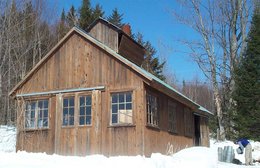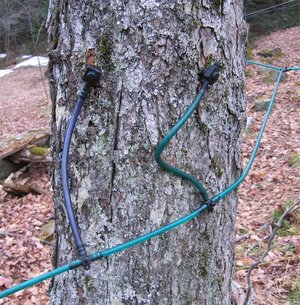Maple syrup
|
|
Maple syrup is a sweetener made from the sap of maple trees. It is most often eaten with pancakes or waffles, but can also be used as an ingredient in baking or in preparing desserts.
| Contents |
Production
Maple_syrop_bucket_OF.jpg
Real maple syrup comes from Canada, particularly Quebec, and the northern United States, especially New England and New York. Most maple trees can be used as a source of sap, but the sugar maple (Acer saccharum) and black maple (A. nigrum) are the most favored, with professionals preferring the black over the sugar. A maple syrup production farm is called a sugarbush or the sugarwoods. Sap is boiled in a "sugar shanty", "sugar shack", or "sugarhouse", which only has partial side walls, being louvered at the top to vent moisture-laden air.
The province of Quebec in Canada is by far the world's largest producer of maple syrup, producing 15,600,000 litres in 2001 - about four times as much as all U.S. production combined. The provinces of Ontario and New Brunswick produce much smaller amounts, about 1,040,000 litres and 670,000 litres respectively in 2002.
In Quebec, the process has become part of the culture, and city people often go to cabanes à sucre in early spring, where lavish meals are served with maple syrup accompaniments. Tire sur la neige is a seasonal treat of thick hot syrup poured onto fresh snow then eaten off sticks as it quickly cools. Owing to its economic importance, the maple tree is an emblem of Canada, and its leaf is depicted on its flag.
As for U.S. production, in 2001, Vermont produced 1,040,000 litres of real maple syrup, about a quarter of the U.S. production. Maine and New York state, with about 19 percent each, were next in line.
Grades
In the United States, maple syrup is divided into two major grades named Grade A and Grade B. Grade A is further broken down into three subgrades; Grade A Light Amber (sometimes known as Fancy), Grade A Medium Amber, and Grade A Dark Amber. Grade B is darker than Grade A Dark Amber.
The grades roughly correspond to what point in the season the syrup was made. Grade A Light Amber is early season syrup, while Grade B is late season syrup. Typically Grade A (especially Grade A Light Amber) has a milder, sweeter flavor than Grade B, which is primarily used for cooking and baking.
In Canada, there are three grades containing several colour classes, ranging from Canada #1 (including Extra light, Light, and Medium) through #2 (Amber) and finally #3 (Dark). A typical year's yield will include about 25-30% of each of the #1 colours, 10% Amber, and 2% Dark.
Use
Maple syrup and its artificial imitations are the preferred toppings for pancakes, waffles, and French toast in North America. Maple syrup can also be used for a variety of uses, including:
A topping for:
- baking powder biscuits
- fresh donuts
- fried dough
- fritters
- ice cream
- hot cereal
- fresh fruit (especially grapefruit)
As sweetener for:
- apple sauce
- baked beans
- candied sweet potatoes
- winter squash
- cakes
- pies
- breads
- fudge and other candy
- milkshakes
- tea
- coffee
- hot toddys
Production is concentrated in February or March, depending on local weather conditions. To make the syrup, holes are bored into the maple trees and hollow tubes termed spiles are inserted. These drip the sap into buckets or into plastic pipes. Modern use of plastic tubing with a partial vacuum has enabled increased production. The sap is fed automatically from the storage tank through a valve to a flat stainless steel pan to boil it down until it forms a sweet syrup. The sap/syrup flows among the baffles of the pan, gradually thickening as it flows, and is automatically drawn off when it is sufficiently thick. The process is slow, because most of the water has to boil out of the sap before it is the right consistency. It takes approximately 40 litres of sap to make one litre of maple syrup, and a mature sugar maple produces about 40 liters (10 gallons) of sap during the 4-6 week sugaring season, although this varies greatly with trees and weather. In general, trees are not tapped until they have a diameter of 25 centimeters (10 inches) at chest-height; in New England, that usually means the tree is at least 40 years old.
A very small amount of fat (usually with a pat of butter) is added during the reduction process to reduce the tendency of the boiling sap to froth up. The traditional fuel for the boiling was firewood, but natural or bottled gas is generally used today for more control of the fire. Overheating can damage the syrup, and a pan boiled dry can burn almost explosively.
Maple_evaporator.JPG
The earliest runs are the best quality. The best "sugaring" weather is clear, with days above freezing and nights below freezing, also with snow on the ground. Syrup made late in the season, when there are no longer nightime freezes, is dark, and the flavor is said to be "buddy", which decreases its value. The whole process must be done as quickly as possible. Too much time in storage can induce fermentation in the sap, and too much time boiling can also reduce quality. Usually the whole process from any batch of sap finishes in syrup within just a few hours.
Maple syrup is sometimes boiled down further to make maple sugar, a hard candy usually sold in pressed blocks, and translucent candy (similar to taffy) which may be poured on snow to harden it for eating. Intermediate levels of boiling can also be used to create various intermediate products, including maple cream (less hard and granular than maple sugar, but harder than fudge) and maple butter (creamy, with a consistency slightly less thick than peanut butter).
Most "maple-flavored" syrups on the market today in the United States are imitation maple syrups, usually with little (for advertising purposes) or no real maple content. They are usually thickened far beyond the viscosity of real maple syrup, as well. It is less expensive than real maple syrup. Real maple syrup is almost universally considered superior, although some people who have been raised on maple-flavored syrups without exposure to the genuine article prefer the fake. Quebecers often refer to these cheap imitations as Sirop de poteau ("Pole Syrup"), meaning syrup that has been made by tapping telephone poles.
See also
External links
- "A Sugarbush Tale": Short documentary about small-scale maple-syrup production in Vermont (http://www.studentfilms.com/film/get.do?id=408)
- North American Maple Syrup Producers Manual (http://ohioline.osu.edu/b856/)
- Making Maple Syrup (http://members.iquest.net/~childers/maple/maple.html)
de:Ahornsirup fr:Sirop d'érable ja:メープルシロップ pl:Syrop klonowy


